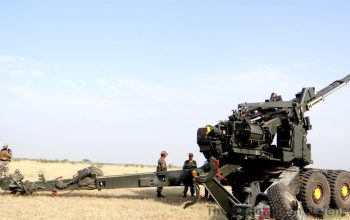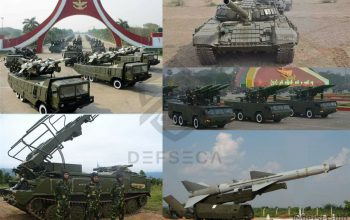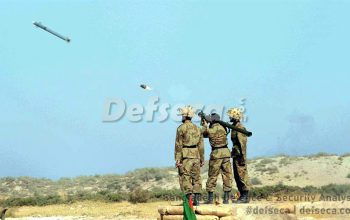At first sight, Pakistan seems an unlikely defence partner for Myanmar. Bilateral relations have never been very close and Pakistan itself has long been preoccupied with its own serious internal problems. Yet a mixture of economic necessity, shared strategic concerns about India and possibly even their common links with China seems to have helped encourage secret military ties. Over the past few decades these ties have not only grown dramatically, but they have consolidated in several important areas.
Arms sales
After the 1988 massacres of pro-democracy demonstrators in Yangon, and the creation of the SLORC, Pakistan was quick to step in with offers of assistance. In January 1989 a senior official from Pakistan’s government arms industry reportedly visited Yangon to offer the regime military supplies. Two months later, a group of senior Tatmadaw officers led by the Myanmar Air Force commander-in-chief Major General Tin Tun made an unpublicised visit to Islamabad. Also on the delegation were Myanmar’s director of ordnance and director of defence industries.
According to Bertil Linter, an agreement was quickly reached for Pakistan to sell SLORC 150 machine guns, 50,000 rounds of ammunition and 5,000 120mm mortar bombs. There also some reports of 76mm and 130mm artillery ammunition being sold as part of the agreement. Not long after the first deliveries were made, Karen insurgents intercepted references to Pakistani munitions in Myanmar Army radio traffic, and unexploded mortar bombs bearing the marks of the government-owned Pakistan Ordnance Factories (POF) were recovered by the KNLA along Myanmar’s eastern border.
On the same visit, the Tatmadaw delegation also inspected Pakistan’s aviation industry complex, leading to accusations by Karen insurgents the following May that Pakistan was training Myanmar Air Force pilots, possibly as part of a comprehensive deal to sell Pakistan-built combat aircraft to the SLORC regime.
In August 1989 Colonel David Abel, Myanmar’s minister of trade and finance (and a former Myanmar Army director of procurement), met with representatives from the Pakistan Ordnance Factories in Bangkok. Possibly as a result of this meeting, other sales followed. For example, it was probably Pakistan which provided Myanmar with its new 106mm M40A1 recoilless rifles, a number of which the Tatmadaw mounted on its jeeps.
According to reliable sources, Pakistan also sent the SLORC a diverse collection of mortars, rocket launchers, assault rifles and ammunition valued at about $20 million. Some of these weapons were made in China and Eastern Europe. Until the practice was stopped by the United States, many of these weapons were reportedly siphoned off shipments sent to Pakistan for use by the anti-Soviet mujahideen in Afghanistan. Arms sales to the Yangon regime were halted for a period by Prime Minister Benazir Bhutto, but after the 1990 Pakistani general elections they were resumed under her successor, Nawaz Sharif. There have been reports these sales included a number of artillery pieces. Indeed, the arms shipments which took place in those critical months of 1989 can now be seen to have marked the beginning of a secret military partnership with Myanmar which has continued to this day.
Over the past twenty years a number of additional reports have surfaced, to the effect that both the armed forces and defence industries of Pakistan and Myanmar have developed a close working relationship. For example, annual sales of ammunition shipments from Pakistan Ordnance Factories continues even as Myanmar painstakingly developed its own defence industries.
These shipments generally included .38 calibre revolver ammunition, 7.62mm machine gun ammunition (and spare barrels for the Tatmadaw’s MG3 machine guns), 77mm rifle-launched grenades, 76mm, 82mm and 106mm recoilless rifle rounds, 120mm mortar bombs, 37mm anti-aircraft gun ammunition, 105mm artillery shells and ammunition for the Myanmar Army’s 155mm long-range guns. As noted above, the latter included HE and white-phosphorous rounds. One shipment even included ammunition for the Myanmar Army’s vintage 25-pounder field guns, provided by the United Kingdom in the 1950s. In addition, Pakistan has provided Myanmar’s arms factories with components for ammunition manufacture such as primers, fuses, and metallic links for machine gun belts.
In July 2000 SPDC Secretary One, Lieutenant General Khin Nyunt, paid a well-publicised visit to the Pakistan Ordnance Factories (POF), accompanied by an 1-member delegation. The Myanmar delegation inspected the range of products made by the POF and were shown various manufacturing processes.
In the past, such high-profile visits helped to consolidate ties considered important to the Myanmar junta. Often, they have preceded further arms sales. There have since been rumours in Yangon that Khin Nyunt purchased a quantity of Stinger surface-to-air missiles, which had earlier been provided to Pakistan by the United States, for use by the mujahideen against the Soviet Union in Afghanistan.
Pakistan has also been associated with Myanmar’s recent purchase of jet trainers and fighter aircraft from China. In June 1998 it was revealed that China would finance a $20 million sale of seven NAMC/PAC Karakorum-8 trainers to the Myanmar Air Force. An order for additional K-8 aircraft followed soon. A total of twelve of the two-seater jet trainers have been already delivered to Myanmar’s Shante air training base. Myanmar is the first customer outside China and Pakistan to receive this aircraft. Its acquisition considerably increases the Myanmar’s ability to train pilots for its expanding fleet of Chinese-made fighter aircraft. The K-8 can be configured for ground attack, with a 23mm gun pod under the fuselage and external storage points. It can carry PL-7 air-to-air missiles, a 12-round pod for 57mm rockets or bombs weighing up to 250 kg. Myanmar Air Force has already carried out sorties on the northern border with China using the K-8 against rebel groups.
The K-8 is manufactured in China, but the Pakistan Aeronatucal Complex has a 25 percent interest in the project. Similarly, Pakistan pledged to export the JF-17 in 2014 and by 2017 the Myanmar Air Force purchased a squadron of JF-17s, making it the first export user of the aircraft outside the manufacturing country.
Myanmar is likely to use the JF-17 jets in part to help combat the Kachin Independence Army (KIA) insurgency in northern Myanmar. The purchase of the JF-17 was also designed to help Myanmar keep parity with neighbouring Bangladesh, which is expected to expand its air force in the coming years through the purchase of advanced Western-origin fighter aircraft. Bangladesh has reportedly been offered and rejected the JF-17.
The Burma Times article noted that the JF-17 “can be armed with a variety of bombs and missiles including PL-5EII, PL-9C and PL-12 AAMs, C-802A anti-ship missiles, general purpose bombs, laser guided munitions and countermeasures on its 7 hard points (four underwing, 2 wingtip, 1 under fuselage). The aircraft’s standard set of armaments are supplemented by a 23 mm GSh-23-2 twin barrel cannon or 30 mm version of the same.”
The governments of Pakistan and Myanmar are now in “advanced negotiations” to licence-build the JF-17, a single-engine multi-role fighter jet, IHS Jane’s Defence Weekly, an independent defence news agency, reported.
While Pakistan is a junior partner in the JF-17 project, the sale indirectly boosts the level of Pakistan’s support for the Tatmadaw’s expansion and modernisation programme.
These arms shipments can only have been made with the full knowledge and support of the Pakistan government. According to the chairman of the Pakistan Ordnance Factories, the POF only supplies arms and ammunition to those countries which are cleared by the Pakistan ministry of defence, and ministry of foreign affairs. In addition to ‘national considerations’, as a general rule this ‘automatically excludes nations that are under a UN-mandated international ban’.
Pakistan presumably interprets this stricture literally, and does not recognise the UN General Assembly’s repeated condemnation of the Myanmar regime for its human rights abuses as a formal UN-mandated ban on arms sales.
Training and intelligence
Pakistan seems also to have provided Myanmar with a wide range of military training. For example, during the early 1990s there were a number of reports that Pakistan had helped members of the Tatmadaw to learn how to operate and maintain those Chinese weapon systems and items of equipment which were also held in Pakistan’s inventory. le For example, it was rumoured that the Pakistan Air Force (which also operates F-7s and A-5s) was helping its Burmese counterpart come to grips with its new Chinese fighter aircraft. Also, the Pakistan Army was reportedly happy to pass on advice to the Myanmar Army about its newly acquired Type-69, Type-63 and Type-59 tanks, and its Chinese-sourced artillery.
Around the same time, there were a number of reports that Pakistan had sent a number of instructors to Myanmar for a period, to help train Burmese Special Forces and airborne personnel at the Myanmar Army’s airborne school at Hmawbi. While these reports still cannot be confirmed, they are given greater credence by the fact that since 1988 more than 40 members of the Tatmadaw have been sent to Pakistan for specialised military training. For example, between 1990 and 1999, 34 Burmese officers attended Pakistani military schools. Sixteen came from the army, 11 from the navy and seven from the air force. A number of Myanmar Army officers are currently in Pakistan undergoing artillery and armour training. Others are attending staff colleges there. The Myanmar Air Force and Myanmar Navy also have officers undergoing training in Pakistan at present. One credible report has even suggested that Myanmara Navy officers were receiving ‘submarine training’ in Pakistan.
While training packages are usually included in Chinese arms deals, it is also possible that Pakistani military personnel have been sent to Myanmar to help the Tatmadazrr learn to operate and maintain its new K-8 jet trainers, and Pakistan may be helping the MA with the 155mm artillery pieces which it acquired from Israel last year.
Given all these contacts, it comes as no surprise that some well-informed observers have recently suggested that the main intelligence agencies of Myanmar and Pakistan have developed a good working relationship. Indeed, there is some evidence that Pakistan’s initial arms shipments to the SLORC in 1989 may have been facilitated by Pakistan’s powerful Inter-Services Intelligence Directorate (ISD, representing senior members of the Pakistan armed forces. It is possible that these arms were sent to Myanmar without the knowledge of Prime Minister Benazir Bhutto, who had some sympathy for Burmese democracy leader Aung San Suu Kyi. (There have also been suggestions that the ISI is recruiting Burmese Muslims to spy against India, but this policy is unlikely to be supported by DDSI, which already has enough to fear from militant Islamic extremist groups.
Pakistan’s obvious price for its assistance to Myanmar would include greater access to information about India, developments along India’s houbled eastern border, and events in Bangladesh. Even if bilateral intelligence ties now amount to little more than periodic exchanges of broad assessments, and discussions about the activities of the major regional powers, such contacts are still important symbols of shared strategic interests.
Regional issues
In some respects, Pakistan’s efforts to increase its military ties with Myanmar, and the Naypyidaw regime’s interest in encouraging such ties, are not unexpected.
For a long time after Myanmar regained its independence in 1948, its relations with Pakistan were quite strained. A heaty of peace and friendship was signed in1952, but frictions along Myanmar’s border with East Pakistan (now Bangladesh), territorial disputes, smuggling and suspected Pakistani aid to Muslim insurgents in western Myanmar (known as Mujahids) all served to aggravate tensions.
In the early 1960s the Ne Win regime’s attempts to expel people of subcontinental extraction from Myanmar, and to nationalise most of the country’s commerce and industry, added to pressures on the bilateral relationship . ln “1972 Myanmar’s early recognition of the new state of Bangladesh was in the face of strong criticism from Islamabad, which at one stage even threatened to break off diplomatic relations. Myanmar’s harsh treatment of its Muslim population has exacerbated these tensions. In addition, while Myanmar tried to remain strictly neutral in the India-Pakistan dispute, the Ne Win regime’s fear of its massive neighbour in the west meant that it usually gave good relations with India a high priority. This was sometimes seen by Pakistan to be at its expense.
Under such circumstances, the likelihood of close military ties developing between Myanmar and Pakistan was low. Despite some superficial similarities, the origins and development paths of the Pakistan and Myanmar armed forces were quite different, and they had little in common. While some useful lessons were learnt, and later incorporated into Tatmadaw training manuals, these differences seem to have been recognised by a Burmese delegation sent to Pakistan in the early 1950s to study its military training programmes. Before 1962 Tatmadaw officers would occasionally attend the Pakistan Staff College at Quetta, but even those contacts were broken after Ne Win seized power and imposed his isolationist and xenophobic policies on the country.
Pakistan’s offer of assistance to the SLORC in early 1989 was clearly an opportunistic move by the Islamabad government to take advantage of Myanmar’s straitened circumstances and to outflank India, which under Rajiv Gandhi strongly supported Aung San Suu Kyi and the Burmese pro-democracy movement. Although New Delhi later reversed its policy and sought to improve relations with Myanmar, both Pakistan and Myanmar have since come to recognise a number of common interests. In particular, they both have close political and military ties with China, and share strategic concerns about India.
Myanmar can also provide intelligence about developments in India and Bangladesh. In return, Pakistan can help deflect criticism of Myanmar in multilateral forums like the United Nations. For example, during the late 1980s Pakistan joined China in opposing resolutions against Myanmar in the UN Human Rights Commission (UNHRC) to a lesser extent, Pakistan is also in a position to help protect Myanmar’s interests with the Islamic countries, which on a number of occasions have expressed concern about the treatment of Muslims in Myanmar, including the plight of the Rohingyas in Rakhine State. However, to the SLORC, and now the SPDC, perhaps the greatest practical benefit arising from Myanmar’s ties with Pakistan is that of having a willing (albeit secret) supplier of ammunition and spare parts for the Tatmadaw’s varied inventory of Chinese and Western arms.
Many of the weapon systems used by Myanmar and Pakistan are now the same. Both countries are heavily reliant on Chinese military technology, arms and equipment. The arms inventories of Myanmar and Pakistan are also similar in that they both contain German-designed automatic rifles, light machine guns, and ammunition – all of which are manufactured locally. Both countries still use (and in some cases manufacture) older US and UK arms and ammunition, a legacy of their shared colonial heritage and former links to the western powers. Because of these similarities, and its more advanced technical development, Pakistan is also in a position to provide Myanmar’s armed forces with the kind of arms, specialist technical advice and military training which is no longer on offer from the Western democracies.
Myanmar’s military ties with Pakistan, however, while reasonably modest, and are not without cost.
Politicians and strategic analysts in India, for example, have been quick to point out that the strongest thread which links Naypyidaw and Islamabad is a close relationship with China, which is still seen as India’s greatest long-term threat. It has been suggested, for example, that China is using its ties with Pakistan and Myanmar to surround India with compliant states.
Indeed, some Indian observers believe that in 1988 Pakistan was actually instructed by China to develop relations with Naypyidaw, to meet these wider Chinese strategic imperatives. Other commentators have gone so far as to suggest that, in the event of a major confrontation between China and India, Pakistan and Myanmar could be called upon to provide China with military support, including troops.
Needless to say, such claims have been dismissed by the SLORC and SPDC as fanciful, flying as they do in the face of Myanmar’s deep commitment to independence and neutrality in world affairs. After one characteristic outburst by Indian foreign minister Fernandes, who openly accused Myanmar of hosting Chinese military facilities, the Myanmar regime invited Indian observers to visit a number of Burmese military bases, to satisfy themselves that China has not established PLA units there. So far, however, India has not accepted this offer.
Even so, evidence of continuing military links between Myanmar and Pakistan, as represented by the most recent arms sales to the Tatmadaw, will add to the fears of Indian strategic analysts and others with an interest in the region’s future stability.
India emulates Pakistan’s ties with Myanmar
Interestingly in recent years India stepped up military cooperation with the Myanmar regime with the most significant transfer being the sale of a Russian-made Kilo class submarine. India also supplied the Myanmar Army with obsolete T-54 tanks, used 105mm artillery, second-hand British-maritime patrol aircraft. New equipment such as naval munitions, components such as hull mounted sonar systems and fire control radar systems for the Myanmar Navy’s warships have also been sold by state-owned enterprises of India as a counter to the deep relations enjoyed by China and Pakistan with the Myanmar armed forces.




